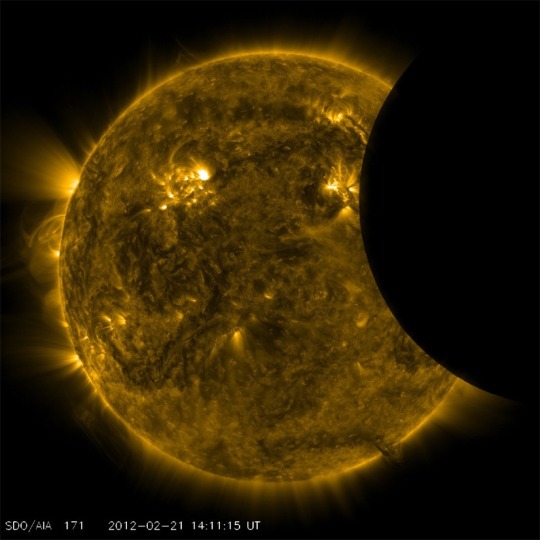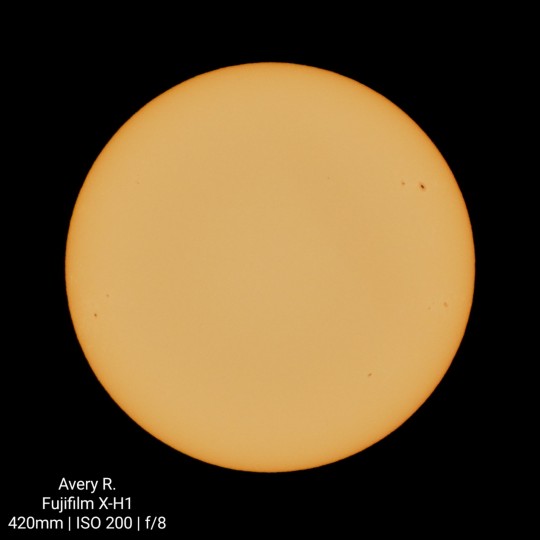#SDO
Explore tagged Tumblr posts
Text
Plasma clouds over the surface of the Sun
471 notes
·
View notes
Text

Our Sun !
A main sequence star, emits a strong solar flare flashes in this image captured by NASA's Solar Dynamics Observatory.
NASA/SDO
#art#cosmos#cosmic#universe#blast#space#sun#flare#solar flare#SDO#nasa#solar dynamics observatory#photography
66 notes
·
View notes
Text



Partial Solar Eclipse Seen From Space
82 notes
·
View notes
Text

solar dynamic observatory, 1/28. Our Sun.
7 notes
·
View notes
Text


Testing out solar photography before the 2024 total eclipse next month! Thought it would be fun to compare my photo to today's SDO satellite image
36 notes
·
View notes
Text
Sun Releases 2 of its Strongest Flares yet on May 11, 2024 | 24h time-lapse (AIA 0304 Å) Courtesy of NASA/SDO, AIA, EVE, & HMI science teams.
The Sun emitted two of its strongest solar flares yet from an active sunspot region called AR3664, peaking at 01:23am UTC on May 11, 2024, and 11:44am UTC on May 11, 2024. NASA’s Solar Dynamics Observatory, which watches the Sun constantly, captured images of the events. Solar flares are powerful bursts of energy. Flares and solar eruptions can impact radio communications, electric power grids, navigation signals, and pose risks to spacecraft and astronauts. The flares are classified as X5.8 and X1.5-class flares, respectively. X-class denotes the most intense flares, while the number provides more information about its strength.
Excerpt from NASA Solar Cycle 25 blog post
#NASA#space#solar storm#geomagnetic storms#solar flare#northern lights#aurora borealis#video#SDO#sun
21 notes
·
View notes
Text

Space Weather News https://spaceweather.com THE STRONGEST FLARE YET:
Sunspot AR3842 exploded again today, producing the strongest solar flare of Solar Cycle 25 so far.
The X9-category blast hurled a CME directly toward Earth.
This makes two CMEs now en route to our planet.
The forecast calls for auroras this weekend.
#science#space#astronomy#physics#news#nasa#astrophysics#spacetimewithstuartgary#starstuff#spacetime#sdo#space weather#geomagnetic storm
7 notes
·
View notes
Photo

Magnificent CME Erupts on the Sun - August 31 by NASA Goddard Photo and Video https://flic.kr/p/d5UHiu
39 notes
·
View notes
Text
I'm gonna try using this site more, hope yall like my dumb drone face because it ain't going anywhere
2 notes
·
View notes
Text
It should be noted that almost all of these are false color. Specifically the most colorful ones are ultraviolet imagages from the AIA instrument on the Solar Dynamics Observatory. They're all monochromatic images but they're colored the way they are so they can be overlayed to make a composite that shows activity in several spectral bands at once - taking advantage of the fact that human visual systems easily recognize magentas, cyans and yellows etc. created by overlaying different colors of light.
Do you like the color of the Sun?

Get ready to be dazzled by the true spectrum of solar beauty. From fiery reds to cool blues, explore the vibrant hues of the Sun in a mesmerizing color order. These images were taken in a wavelength of extreme ultraviolet light to clearly see any activity on the surface of the Sun — giving scientists a wealth of data for solar studies.
#SDO#AIA#Sun#false color images#UV imagery#tho the ones with visible sunspots (rather than prominences)#might be visible light#I'm not as well versed in those images
37K notes
·
View notes
Text
Huge tornados of plasma on the Sun
16 notes
·
View notes
Text
संकट में बोकारो MLA श्वेता सिंह: 4 वोटर ID रखने पर SDO ने भेजा नोटिस, पहले से 2 पैन कार्ड की जांच जारी
Bokaro MLA Shweta Singh: बोकारो से कांग्रे�� विधायक श्वेता सिंह की मुश्किलें लगातार बढ़ती जा रही हैं, जिन पर अब एक नया गंभीर आरोप लगा है. पहले से ही दो पैन कार्ड रखने के मामले में चुनाव आयोग ने आयकर विभाग को जांच के निर्देश दिए हैं, वहीं अब चास एसडीओ प्रांजल ढाढा ने भी उन्हें नोटिस जारी किया है. यह नोटिस विधायक द्वारा चार मतदाता पहचान पत्र रखने से संबंधित एक शिकायत के आधार पर भेजा गया है. एसडीओ ने…
#Biranchi Narayan#Bokaro#Chas#Election Commission#Investigation#MLA Shweta Singh#notice#PAN cards#SDO#voter ID cards
0 notes
Text
31 अक्टूबर तक केवाईसी करवाएं बिजली उपभोक्ता, एसडीओ ने जारी किए आदेश; नहीं तो सभी सुविधाएं होगी बंद
Mandi News: बिजली बोर्ड ने उपभोक्ताओं को 31 अक्तूबर तक ईकेवाईसी करवाने के आदेश जारी किए हैं। एसडीओ कार्यालय जंजैहली से जारी अधिसूचना के अनुसार बिजली बोर्ड के घरेलू, व्यावसायिक और होटलों में लगे सभी मीटरों के लिए ईकेवाईसी करवाना अनिवार्य है। ई-केवाईसी न करवाने वाले उपभोक्ताओं को बोर्ड की ओर से दी जाने वाली सभी सुविधाएं बंद कर दी जाएंगी और कनेक्शन भी काटा जा सकता है। वर्तमान में प्रदेश में 300…
0 notes
Text
El Sol vomitó una fuerte y espeluznante erupción solar
El Sol emitió una fuerte llamarada solar, alcanzando su punto máximo a las 4:55 p.m. EST, el 31 de diciembre de 2023. El Observatorio de Dinámica Solar de la NASA, que observa el sol constantemente, capturó una imagen del evento. 2 enero 2024: Eyección de Masa Coronal Las erupciones solares son poderosas explosiones de energía. Las llamaradas y erupciones solares pueden afectar las…

View On WordPress
0 notes
Text
Los agujeros coronales: una ventana al viento solar
Un agujero coronal típico visto por el Observatorio de Dinámica Solar de la NASA. Cc: SpacewatherLive.com Los agujeros coronales son regiones oscuras de la corona solar, la capa exterior del Sol. Apareces oscuras porque no emiten mucha radiación, a diferencia de las regiones circundantes. Los agujeros coronales son importantes porque son la fuente del viento solar, un flujo de partículas…

View On WordPress
0 notes
